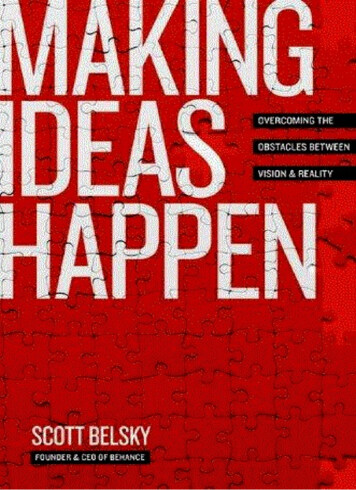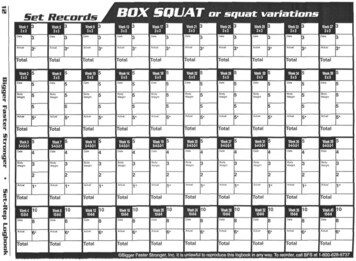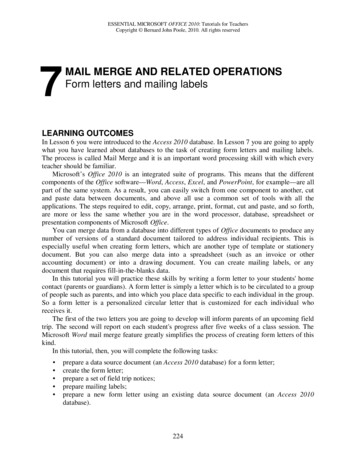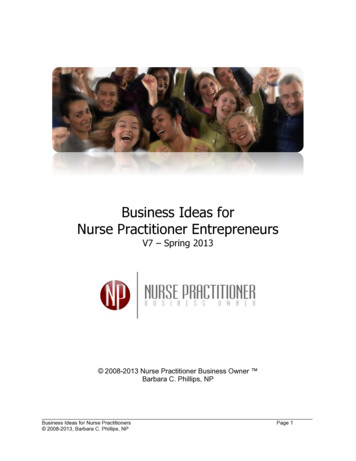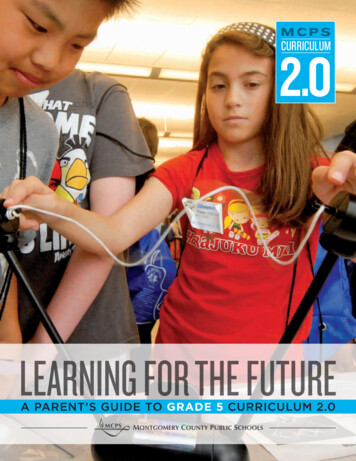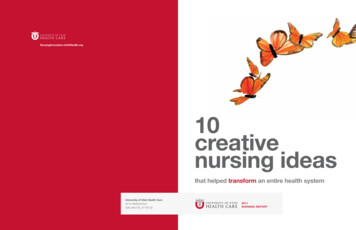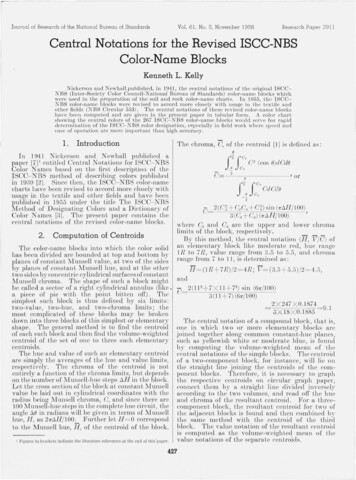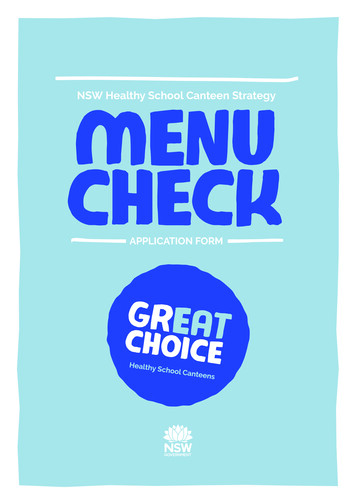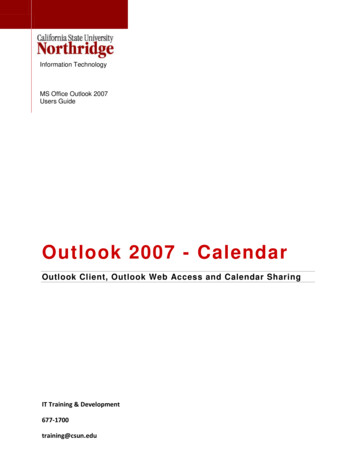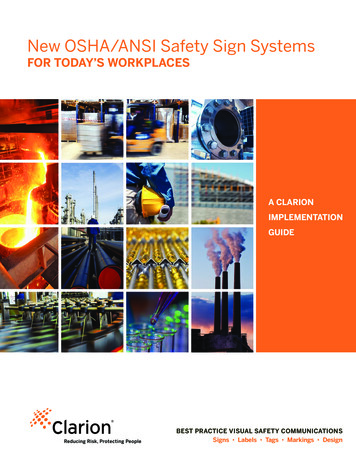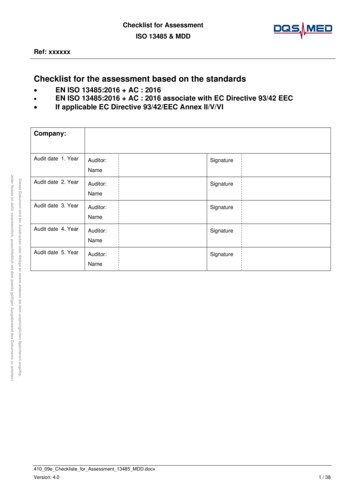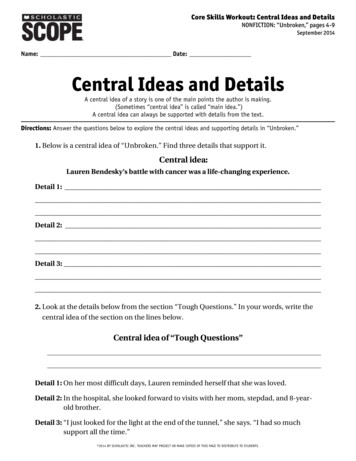
Transcription
Core Skills Workout: Central Ideas and Detailsnonfiction: “Unbroken,” pages 4-9September 2014Name: Date:Central Ideas and DetailsA central idea of a story is one of the main points the author is making.(Sometimes “central idea” is called “main idea.”)A central idea can always be supported with details from the text.Directions: Answer the questions below to explore the central ideas and supporting details in “Unbroken.”1. Below is a central idea of “Unbroken.” Find three details that support it.Central idea:Lauren Bendesky’s battle with cancer was a life-changing experience.Detail 1:Detail 2:Detail 3:2. Look at the details below from the section “Tough Questions.” In your words, write thecentral idea of the section on the lines below.Central idea of “Tough Questions”Detail 1: On her most difficult days, Lauren reminded herself that she was loved.Detail 2: In the hospital, she looked forward to visits with her mom, stepdad, and 8-yearold brother.Detail 3: “I just looked for the light at the end of the tunnel,” she says. “I had so muchsupport all the time.” 2014 by Scholastic Inc. Teachers may project or make copies of this page to distribute to students.
Core Skills WorkoutREFERENCE: Central Ideas and Details THE LANGUAGE ARTS MAGAZINEWhat is a central idea?A central idea is a main point that the author ismaking (also called a main idea or a key idea).In other words, a central idea is what the articleis mostly about. You can think of a central idea asa thesis statement: one sentence that states whatthe article is about. A text could have more thanone central idea.A central idea can always be supported with detailsfrom the text. HINT: When you search for centralideas, be sure to pay special attention to titles,subheadings, and the first and last sentences ofeach section. 2014 by Scholastic Inc. Teachers may project or make copies of this page to distribute to students.
Core Skills Workout: Summarizingnonfiction: “Unbroken,” pages 4-9September 2014 THE LANGUAGE ARTS MAGAZINEName: Date:SummarizingAn objective summary is a short statement or paragraph that tells what an article is about.It does not include irrelevant details or the opinions of the person writing it.Directions: Follow the prompts in the margins to complete the summary below.Summary of “Unbroken”“Unbroken” is about2. What diddoctorsfind? Whatkind ofcancerdoes Laurenhave?Lauren was perfectly healthy until May 2012, whenLauren’slife changeonceshe wasdiagnosed?To treat the deadly disease, Laurenfaced many challenges, includingBut throughout her struggle, LaurenOne thing that helped6. Where didLauren andher familygo? How didit changeher?article mainlyabout? Whatproblem doesshe face?Lauren4. How did1. Who is the3. Whattherapiesdid Laurenundergo?What aresome sideeffects?5. What wasLauren’sattitudeduring hertreatments?Lauren wasNow, Lauren 2014 by Scholastic Inc. Teachers may project or make copies of this page to distribute to students.7. How doesLaurenhelp otherpeople?
Core Skills Workout: Making InferencesFiction: “Dear Future,” pages 26-31September 2014 THE LANGUAGE ARTS MAGAZINEName: Date:Making InferencesMaking an inference means using clues from the text to reach a conclusion.Directions: Read “Dear Future,” then make inferences to answer the questions below. We answered the first question for you.1 . How does James feel when he sees the Ray Bradbury book?He is embarrassed and ashamed. He remembers when he blurtedsomething out in class about a Bradbury story only to be told thatthe class had finished discussing it 10 minutes earlier.Explain how you know.James refers to the book as “mocking me,” and pales“aseverything comes flooding back.” Recalling how his classmates laughedathim, he says, “I think my heart stopped beating.”2. What is it about Annie’s journal that James finds so interesting?Explain how you know. 3. What does James learn from his conversations with Annie and with his parents?Explain how you know. 2014 by Scholastic Inc. Teachers may project or make copies of this page to distribute to students.
Core Skills Workout: MoodDrama: The Rocket’s Red Glare, pages 10-16September 2014 THE LANGUAGE ARTS MAGAZINEName: Date:Exploring MoodMood is the feeling the reader gets from reading a piece of writing. Another way to describe mood is atmosphere.When you walk into a place, it has an atmosphere that makes you feel a certain way; when you “walk into” a story, it toohas an atmosphere that creates a feeling. Authors create mood through word choice, imagery, dialogue, setting, and plot.Directions: Read The Rocket’s Red Glare, then answer the questions below to explore the mood of different scenes. 1. The mood of Scene 1 is welcoming and determined. Which details help create this mood?2. Consider the mood of Scene 2.A. Circle the word that best describes the mood of Scene 2.disappointedanxiousexhaustedB. How do the stage directions—that is, the lines in the narration that describe the characters’movements—contribute to that mood?C. Which other details in Scene 2 help create the mood?3. What is the mood of Scene 5? Choose a line in Scene 5 and explain how it helps create that mood.4. What imagery does the author use in Scene 6? What mood do these descriptions create?5. Describe the mood of Scene 7. At what point does the mood shift? Explain. 2014 by Scholastic Inc. Teachers may project or make copies of this page to distribute to students.
Core Skills Workout: Text EvidencePaired Texts: “The Volcano That Changed the World,” pages 22-25September 2014 THE LANGUAGE ARTS MAGAZINEName: Date:Find the Text EvidenceDirections: Read “The Volcano That Changed the World,” then read the questions below carefully. Some will ask you toselect or find pieces of text evidence—that is, details in the article—that support a statement we provide. Others willask you to support your own statement with text evidence.1. Choose the THREE pieces of text evidence that best support the statement below.John Hoisington and his father had reason to worry thatthe snowstorm of June 1816 would devastate their family.A “Summer was just two weeks away.”B “This storm would kill all their crops.”C “Like most people in 1816, the Hoisingtons grew almost everything they ate. . . .”D “Snow destroyed thousands of other East Coast farms, from Virginia up to Maine.”E “Were witches to blame?”F “There would be little food for the family or their animals.”2. Choose one piece of evidence that best supports the statement below.Then complete the sentence to explain why you made your choice.The stormy weather resulting from Tambora’s eruptionaffected migration in the United States.A “John saw the look of fear in his father’s eyes as they watched the snow swirling outside.”B “John and his family didn’t know it, but during that strange summer of 1816, similar weatherdisasters would unfold throughout New England—and the world.”C “Tens of thousands of other New England farmers made similar journeys, all driven west bythe hardships of 1816.”I chose because 2014 by Scholastic Inc. Teachers may project or make copies of this page to distribute to students.page 1 of 2
Core Skills Workout: Text EvidencePaired Texts: “The Volcano That Changed the World,” pages 22-25September 20143. Below is a quote from the article and two pieces of evidence that support it.Find one more piece of evidence and write it on the blank lines. “The eruption of Tambora in 1815 was the most deadly andpowerful volcanic eruption in human history.”A “Its explosive energy was 10 times stronger than that of Krakatoa, history’s most famousvolcano, which erupted in 1883, also in what is now Indonesia.”B “The eruption went on for more than three days, a deadly storm of fire, gas, ash, and rock.”C4. Read the lines from the article below. Write a statement that they support.A “It is only now, nearly 200 years later, that scientists have finally solved the mystery.”B “Using satellites and computers, scientists tracked Pinatubo’s cloud as it spreadacross the world.”C “Today, scientists know that volcanoes can have a major impact on weather worldwide.”5. Now it’s your turn. Make a statement based on the article and find three pieces oftext evidence to support it.ABC 2014 by Scholastic Inc. Teachers may project or make copies of this page to distribute to students.page 2 of 2
Core Skills Workout: Text FeaturesPaired Texts: “The Volcano That Changed the World,” pages 22-25September 2014 THE LANGUAGE ARTS MAGAZINEName: Date:Exploring Text FeaturesAuthors use text features to bring attention to important details. In a nonfiction article,text features include titles, subheadings, photos, captions, charts, and maps.Directions: Answer the questions below to help you explore the text features in “The Volcano That Changed the World.”1. Look at the large headline on pages 22 and 23. How does the photo and the shape of the word“volcano” help readers understand what the story is about?2. Describe the images on page 24. Why do you think the article includes these?3. Read the paragraph on page 24 that starts, “What people were paying attention to . . . .” How does themap on page 25 further illustrate the point made in that paragraph?4. Read the two captions on page 24. In which section of the article would this information best fit? 5. The map on page 25 shows that Tambora’s volcanic cloud affected regions that were manythousands of miles away from Indonesia. Explain how this was possible.6. Reread the section “A Ruined Land.” What could be an alternate subheading for this section? 2014 by Scholastic Inc. Teachers may project or make copies of this page to distribute to students.
Core Skills Workout: Text Structurespaired texts: “The Volcano That Changed the World,” pages 22-25September 2014 THE LANGUAGE ARTS MAGAZINEName: Date:Exploring Text Structures“Text structure” is the term for how an author organizes information. Authors use different text structuresto achieve different purposes, and there might be several types of text structures in a piece of writing.Directions: Common text structures are listed in the boxes on the right. Use the information in these boxes to help youanswer the questions below about the text structures in “The Volcano That Changed the World.”1. W hat is the main purpose of the article?Which text structure does the author mostly use to achieve Descriptionincludes details to helpyou picture or get to knowa person, a place, a thing,or an idea.this purpose?2. R eread the first section. Which text structure does the authormainly use in this section? Explain your answerCause and Effectexplains why somethinghappened (cause) andwhat happened as a result(effect).using examples.Problem and Solutionpresents a problem andexplains how it is solved.3. W hich text structure does the author mainly use in thesection “Ignored and Forgotten”? Explain your answer usingexamples.Compare and Contrastpresents the similaritiesand/or differencesbetween two items, suchas a pair of events, timeperiods, ideas, or places.Why do you think the author uses this text structure?Sequence of Eventsdescribes events in theorder in which theyhappen. This is also calledchronological order. 2014 by Scholastic Inc. Teachers may project or make copies of this page to distribute to students.page 1 of 2
Core Skills Workout: Text Structurespaired texts: “The Volcano That Changed the World,” pages 22-25September 20144. W hich text structure does the author mainly use in the first three paragraphs of “Solvinga Mystery”? Explain your answer using examples.How does this text structure add to your understanding of the topic?5. Look at the infographic on page 25. Imagine that the author put this information into aparagraph rather than on a map. What text structure would then be best to use? Why?Write a paragraph using the information in the infographic “The Eruption FeltAround the World.” Use your answer to question 5 to help you. 2014 by Scholastic Inc. Teachers may project or make copies of this page to distribute to students.page 2 of 2
Core Skills Workout: ToneDebate: “Your Favorite Drinks Can Wreck Your Body,” pages 17-21September 2014 THE LANGUAGE ARTS MAGAZINEName: Date:What’s the Tone?Tone is the author’s attitude toward the subject he or she is writing about, or toward the reader.Words that could describe tone include doubtful, humorous, gleeful, serious, and questioning.Tone is conveyed through the author’s word choices and the details that he or she includes.Directions: Read “Your Favorite Drinks Can Wreck Your Body.” Then answer the questions below to explore the tone ofeach essay.“YES!” by Russ Lloyd1. I n the box below, list words and phrases that Lloyd uses to describe sugar, soda, and other sugarydrinks. We listed two for you.Words and phrases the author uses to describe sugar and sugary drinkskiller on the looseaddictive2. Based on your list, how would you describe the author’s attitude toward sugary drinks?3. Consider the following quote from the article:“You know who doesn’t want warning labels on sugary drinks? The beverage corporationsthat spend hundreds of millions of dollars trying to get you to buy their drinks.” (p. 19)What attitude toward beverage companies does this quote reveal? Explain your answer. 2014 by Scholastic Inc. Teachers may project or make copies of this page to distribute to students.page 1 of 3
Core Skills Workout: ToneDebate: “Your Favorite Drinks Can Wreck Your Body,” pages 17-21September 20144. Consider these two sentences from the section “The Worst”:“A single 12-ounce can of soda contains a whopping 8 teaspoons [of sugar]!”“When you chug down a bottle of soda, you send a truckload of fructose straight to your liver.”Note the words whopping, chug, and truckload in these sentences. How do these wordsaffect the tone? What do the words reveal about the author’s attitude?“NO!” by Evan Cook5. Consider this paragraph from the section “Wrong Approach”:“First of all, soda is not the only cause of obesity. Not even close. Inactivity and overeatingcan both contribute to obesity. And as a representative for CalBev, California’s branch ofthe American Beverage Association, points out, ‘Only 4 percent of calories in the averageAmerican diet are derived directly from soda.’ ” (p. 20)What does the information the author includes reveal about Cook’s attitude toward sugarydrinks? Explain your answer.6. Circle TWO words in the following list that best describe the tone of the last section,“Leave Us sExplain your choices. What words or details did the author use to create that tone? 2014 by Scholastic Inc. Teachers may project or make copies of this page to distribute to students.page 2 of 3
Core Skills Workout: ToneDebate: “Your Favorite Drinks Can Wreck Your Body,” pages 17-21September 2014The Whole Debate7. Compare and contrast the tones of the two essays. Use text evidence to support your claims. 2014 by Scholastic Inc. Teachers may project or make copies of this page to distribute to students.page 3 of 3
Exploring Text Features Authors use text features to bring attention to important details. In a nonfiction article, text features include titles, subheadings, photos, captions, charts, and maps. Directions:Answer the questions below to help you explore the text features in "The Volcano That Changed the World."
